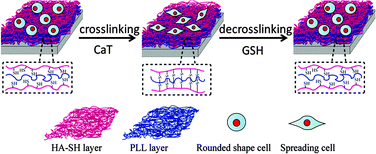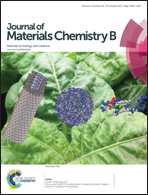Dynamic stiffness of polyelectrolyte multilayer films based on disulfide bonds for in situ control of cell adhesion
Abstract
The stiffness of the substrates has been found to have a strong effect on cell behaviors, especially on cell adhesion, which is the first cellular event when cells contact materials. Much effort has been made to develop the materials with controlled stiffness for regulating cell adhesion. However, most available strategies for controlling the stiffness of material surfaces are generally limited to be static, which means that the stiffness is fixed during cell adhesion. Herein, we developed polyelectrolyte multilayer films (PEMs), and their stiffness can be dynamically modulated by mild stimuli. The PEMs were made by alternative deposition of poly-L-lysine (PLL) and thiol group modified hyaluronan (HA-SH) using the layer-by-layer assembly technique. The (PLL/HA-SH) multilayers can be cross-linked via oxidation of thiol groups. After crosslinking, the stiffness was increased and the adhesion of fibroblast cells was promoted. The stiffness of the multilayer films can be down-regulated dynamically by adding glutathione (GSH) in the medium, leading to in situ reduction of cell adhesion. Our study provides a promising strategy for the development of material surfaces with dynamically changeable stiffness, which is of great potential in the field of cell-based biomaterials.


 Please wait while we load your content...
Please wait while we load your content...